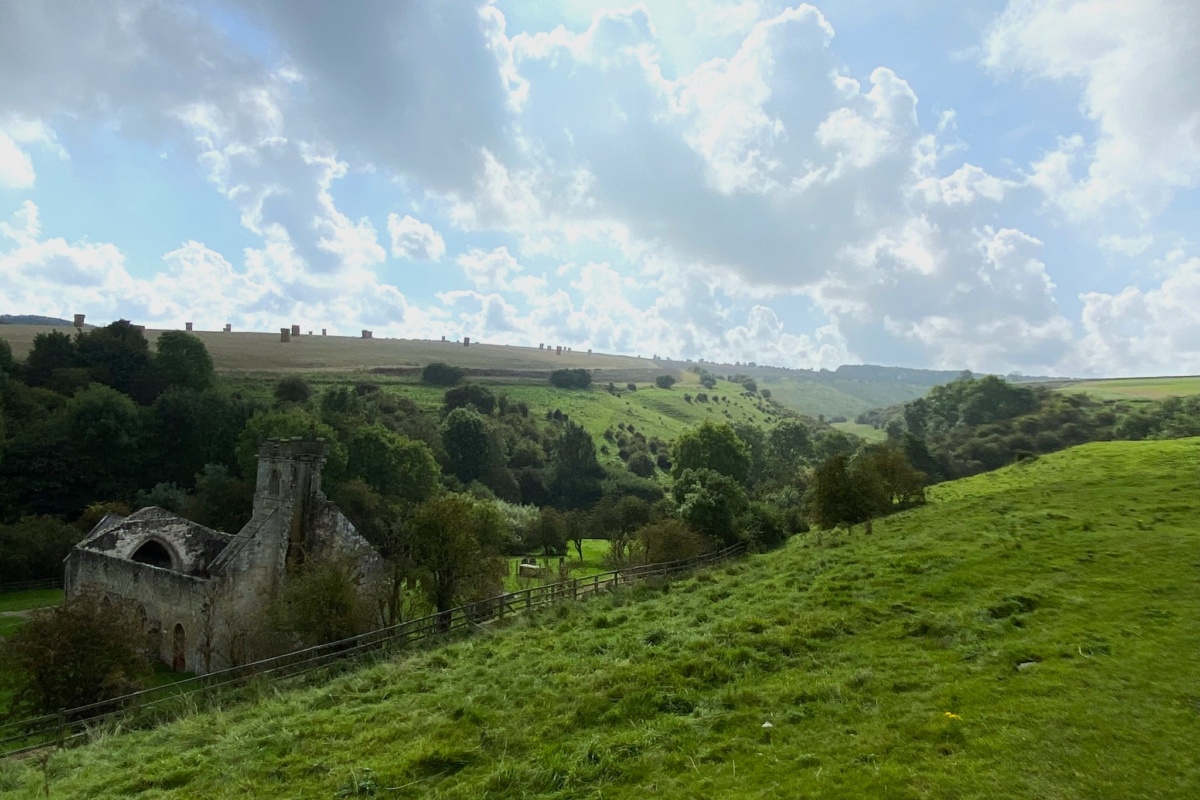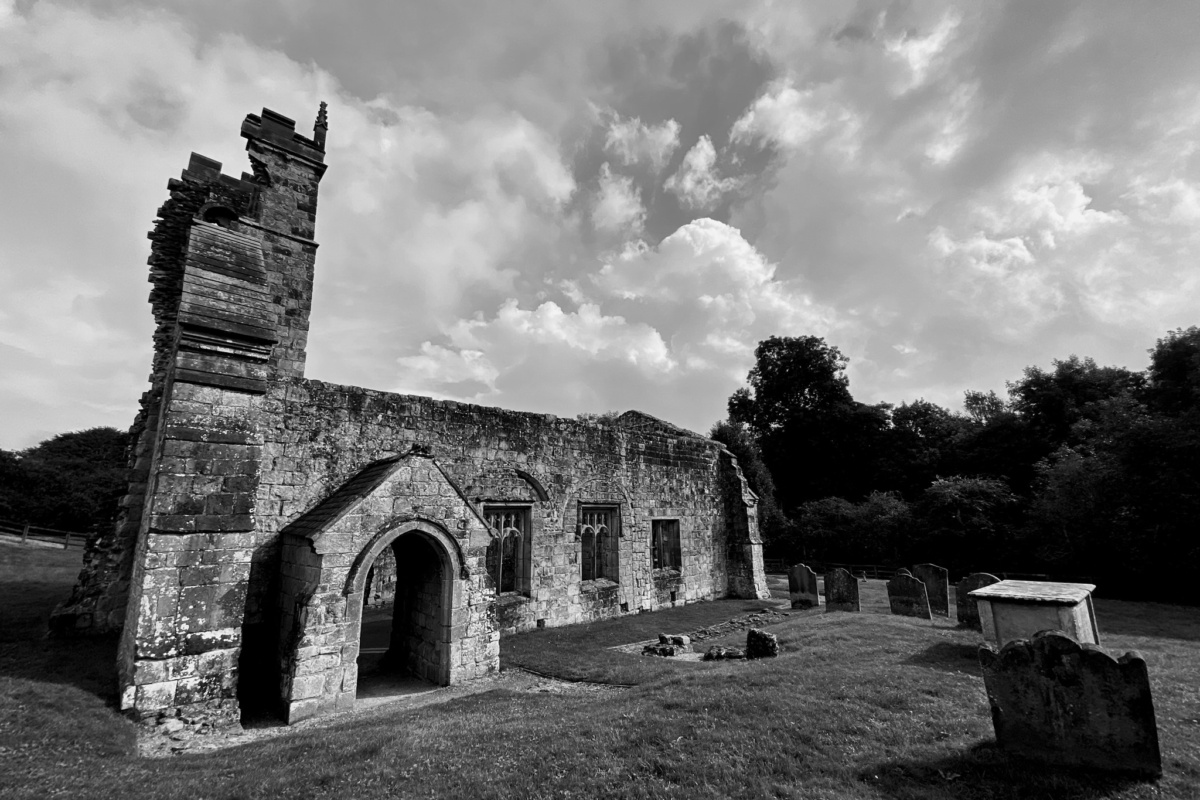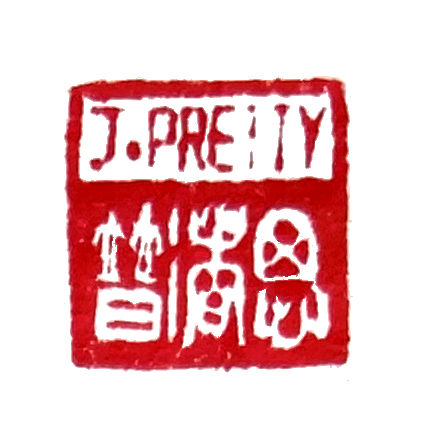[reading time: 8.5 mins]
“The law locks up the man or woman,
Who steals the goose from off the common,
But lets the great villain loose,
Who steals the common from off the goose.”
[Anon/Traditional England, 1820s]
The man makes a startling discovery.
He’s only in his twenties. His words are about to change a whole field of thought. This shifts him onto a new path, for the next sixty years.
At first, of course, no one believes him.
Maurice Beresford walks like his dog, eyes down, also a bit scruffy. He’s friendly, as inquisitive as any investigator. He sees the world sideways to established norms.
Those lumps and bumps in the fields, long grassed-over earthworks, they could be house platforms. The worn depressions between, maybe streets. The whole hillside organised in some lattice. An old village.
There’s no name for this place on any map. There’s a lonesome church, down by the river and fishponds.
When you find yourself on the bow wave of a new paradigm, it’s the old guard who’ll be angry. You’re showing them up, calling careers into question.
What to do? Hold back, or press on through the briars?
It’s the 1940s, and Maurice of the middle marches, he knows he likes to blur the lines. He’s had to as a conscientious objector. He stops to pick up a white feather, thrown down in the street before him.
He says, “The wolf? He blows down your house and he blows down my house too.”
And carries on walking. In the week, working at social work and adult education, mapping old field systems at the weekends.
He wants to know, what was the extent of the common field system, the open fields, in old England.
Was there more collective farming than historians want to tell? If so, what happened to the villages?
How did time come to run out for them?
Lots of questions.
He finds in the nooks and crannies of documents: oblique references to vanished villages.
He travels by bus to hidden places. He walks in, down long paths and sunken lanes. Past scrub and thorn.
He writes: “No traveller comes easily to a lost village. You must be friend to mud, to green lanes and unused footpaths, to rotting footbridge and broken stile, to brambles and to barbed wire. It is a landscape that has forgotten humans. It is so long since anyone wanted to come this way.”
What he’s seeing, written in and on the soil is this. Evidence of the long war on the commons.
The taking of land and places owned by communities, managed by them for centuries, then seized.
Maurice and his historian colleagues face a dilemma. No one believes this capture happened much. What to call these villages? What story to tell?
They have to establish credibility for the new research, for the digging they need money. So words matter. How not to scare the gatekeepers, they need to access funds. They choose to call them deserted villages, sometimes lost villages. In the passive.
What they know: these were stolen.
Stolen Medieval Villages. Over the years, they come to find more than three thousand Deserted Medieval Villages of old England.
They dig at one famed discovery for forty years. It’s Wharram Percy, on the west side of the chalk Wolds of North Yorkshire. He discovers the village one glorious June three years after the war ends.
He travels by bus with two friends, following hints. They stay at a youth hostel, catch a local bus, walk along the web of attractive footpaths.
The corn is waist-high, they go in, come to disused St Martin’s Church. There are broken gravestones, and on the hill above, an astonishing array of earthworks.
You come today to Wharram Percy down a mile-long chalk lane, inside high hedges, copses of woodland on the skyline. It’s autumn, so there are red haws and hips in great number. Under a broken wooden bridge, across a rail line long closed, up the steep slope.
There’s the one ruin, the stone church now has no roof and the tower’s partially fallen. There’s the old manor house, a large fishpond. Black cattle laze in the upper pasture. Here is Water Lane, here Town Gate. Over there Town Street. Here a hollow way, worn by cartwheel and hooves and the feet of people.
Each house is a rectangular croft, connected to a toft outbuilding. Access out the back as well as the front. The whole village oval in shape. And fields of ridge and furrow, the common fields where farmers held strips side by side.
Wind gusts across the open hillside, a storm builds to the west.
Maurice was by now known for his warm smile, it reflected all that he had learned from the land.
He likes to address an audience. Especially when they’re in one of his fields. Hands on hips, wearing a beret, his trousers tucked into the top of his boots. He deserves these moments.
What the archaeologists discover about Wharram Percy is this. It was established by at least the start of Anglo-Saxon times.
What is known too: the common field system of agriculture took off at this time. After four hundred years of imperial Roman rule, people have a distinct taste for the collective. It helps them get through hard times. This sharing raises all ships. They establish rules and norms. They set agreed sanctions for rule-breakers.
Are we all in this together?
And this is how we’ll look after the river and springs, the woodlands, fish, animals. How we’ll cut and carry hay and feed, wood to burn, and yet leave enough for the next year, for the next generation. Rules on how many animals each can put on the commons without causing over-grazing.
The common field system comes to last fourteen hundred years.
The Anglo-Saxon ethic of wyrd, the web that links all living things, this helps to govern the commons.
Some will say, it was inefficient and unproductive. It held people back, the country too.
In the 1960s, a Texan ecologist, obsessed with the threat of over-population, he writes a famed article. He says all commons inevitably lead to tragedies. It’s what people do. They are selfish, look after only themselves. They’ll break the rules and so the system will soon collapse.
The enclosures came as waves.
The first is in the 1200s-1300s, large landowners realise sheep need little labour but much land. Wool and textiles are the new route to riches.
In the 1500s, the Tudors have spent the family silver. Henry VIII wants to put one over Rome. He closes monasteries, confiscates their land, hands acres out to friends. It’s all so easy.
In the mid-1600s, the king is out of money and realises: drain the fens and wetlands, and you have farmland acres for free. He parcels it out to friends, makes them pay him. A rebellion is led by a man from near the Fens called Cromwell. He wins the Civil War. Chops off the king’s head.
Then, ah, he’s a convert. Drainage is a fine idea. The wet-footed people carry on local rebellions for half a century.
Phase four: use parliament to do the heavy work. Between 1700 and 1850, 4500 Enclosure Acts of Parliament are passed. They break up the common fields and wastelands, the biodiversity-rich wilds. At the same time, the Highland Clearances in Scotland press on. Cruel, relentless, good for the winners. The giants get bigger.
Follow Maurice’s wanderings and you’ll find echoes. A five-hour walk from Wharram Percy to Castle Howard. The celebrated house, wide lawns. The view south created by levelling terraces, moving peasant homes, the wastes and wildness pushed away. Beresford says, “Many a lost village stands in the shadows of the Great House.” At Castle Howard, another village on the north side goes under the ornamental lake.
And then a fifth phase. The late 20th century privatisation of public institutions, sweetened by public subsidy and asset transfer. Water companies are created debt-free, given 175,000 hectares of land. They’re borrow against these assets to take on new debt. What would anyone do? Underinvest, allow infrastructure to degrade, permit sewage pollution of rivers and lakes. This sweetly transfers costs to others.
We are surely living in most enlightened times.
What remains of the commons: village green, allotment, common national forests at Dean, Epping and the New Forest, urban park, the coast and beach, two hundred thousand kilometres of footpaths.
And then, something new. Nature, wildlife and conservation charities and trusts take on half a million hectares of nature reserves and open them to the public. In Scotland, two laws passed to help communities buy back estates and islands once enclosed by distant lairds.
It’s possible to speak old places back into existence. It’s possible too to walk and wander and meet ghost and roaming fox. To meet the goose from off the common.
In Maurice’s middle lands, this is Wormleighton. Today’s village is on a Cotswolds’ hilltop, amidst trees round a sandstone manor house. A sunken lane dense with cow parsley, and ahead a wide expanse of grassland stretching to the valley. The village lives well for five hundred years after award of a charter in 956ce. Until the lord of the manor is given the land by Henry VII. He throws out eighty-five families. A grazier amasses a sheep flock of twenty thousand.
At least he was smiling.
Maurice calls this, “A great annihilation.”
This is Sulby, by a wood of oak and ash. By the path, a red fox stands and looks. On the slopes, ghosts of children running between wood and mud houses, roofed with turf, men strolling to the fields, women walking to the stream.
This is Stanford, a village cleared for the view by owners of the nearby hall. Earthworks round a sunken lane, still wet, veteran oaks in the field, ancient ridge and furrow nearby.
This is Fawcliffe by a busy road, hawthorn following an ancient ridge line up over the hill.
Here are Brauncetonbury and Wolfhamcote, each enclosed after five hundred years of charter. A ridge and furrow open field, a badger sett in a corner.
This is Cublington, a deserted community at the edge of the new village.
Across the valley, the rumble of a dawn train, the whine of chainsaw. A dog yelping. Dark clouds in the west.
The prospects. Still good, for growth of the economy.
 Jules Pretty
Jules Pretty



